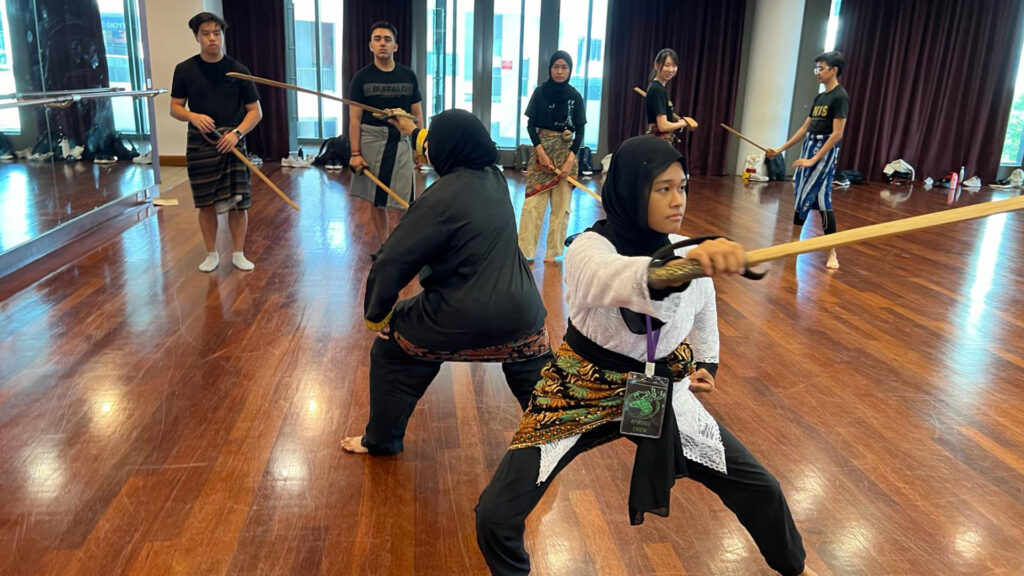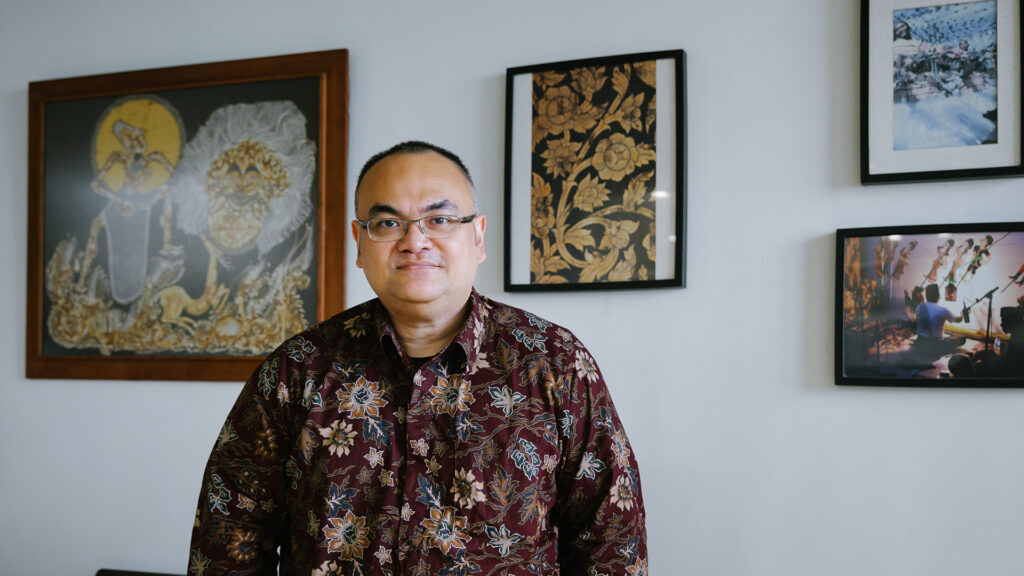Punching Home Lessons about Southeast Asia through Martial Arts
May 23, 2024
IN BRIEF | 10 min read
- From honing basic silat techniques to dabbling in the various styles of martial arts practised in Southeast Asia – such as kung fu and baguazhang from China as well as the Japanese sword-fighting art of kendo – students discover the region’s cultures and history in unconventional ways, in a course conducted by Dr Mohamed Effendy (NUS Southeast Asian Studies).
With their arms stretched out and feet apart, the students practise the sikap pasang – Malay for “ready stance”. At their trainer’s command, they squat and stretch one leg out in unison, performing the sapu dalam, or inside leg sweep.
Students also learnt the langkah perguruan, consisting of strikes and footwork, along with moves such as langkah pedang (the art of the sword), langkah golok (the art of the machete), as well as many different styles of pokolan (kicks and punches).
These youth are not part of a silat club, but students of the Martial Arts in Southeast Asia course in the middle of a supervised silat lesson held on campus. It is just one of many hands-on martial arts sessions they enjoy throughout the course.
Typically, each session begins with a short introduction to a particular martial art, before a professional trainer demonstrates basic techniques. Students then pair up to practise their moves, before learning about the philosophy behind the martial art.
Dr Mohamed Effendy Abdul Hamid, who launched the course in 2015, says such hands-on lessons enable students to learn better by experiencing things for themselves.
“We aim to ignite students’ understanding of the region in less conventional ways,” said the lecturer in the Department of Southeast Asian Studies at the NUS Faculty of Arts and Social Sciences (FASS). “The best way is to practise the cultures embedded in the region, and martial arts can be a window to understanding Southeast Asian cultures.”
Students experience “the warrior spirit, especially resilience” when they practise these martial arts. “This spirit is emblematic of the Southeast Asian spirit itself,” added the martial arts buff, who began reading books about different ancient battles and war philosophies during rest periods while on patrol in the coast guard while serving National Service.

Lessons from the Region and Beyond
Although the course aims to educate students about the region’s cultures, it also taps into martial arts from all over the world, such as kung fu and baguazhang from China, and the Japanese sword-fighting art of kendo which Dr Effendy is trained in.
Dabbling in a wide variety of martial arts helps students grasp an essential truth – Southeast Asia has always been connected to the rest of the world. “Studying martial arts in the region, you can see that we have a long history of exposure to trade and connections with other communities,” he explained.
“For example, Japanese, Malaysian and Filipino martial arts all have a strong emphasis on spirit and ethics during fighting. People in Southeast Asia encounter people from other regions, see how they fight, then adapt things to their own fighting style. This is what we call localisation.”
Another clear example of this “cross-pollination” is how silat warriors greet their opponents with their fists against their palms, a traditional Chinese martial art greeting.
“I had a friend, a kung fu master, who saw a video of silat being practised in Sulawesi, Indonesia, and he told me that silat looks like a martial art with Chinese hands and Malay feet,” Dr Effendy shared. “To me this is a good example of historical exchanges that enriches cultures in the region,” he quipped.

Combat and Core Values
These perspectives on the region’s history brought to life through the martial art forms practised by its people has been illuminating for students.
“We learned through Prof’s class (that) many martial arts had their origins in actual warfare or combat. So certain martial arts may be perhaps more adapted to certain types of combat,” said Bryan Cambo, a Year 1 undergraduate at FASS, who intends to major in Southeast Asian Studies. He cited, for instance, how certain forms of silat are geared towards one-on-one combat and employ the karambit as a tool in battle, reflecting how combat was carried out in earlier times.
Gergana Biserova Atanasova, a Year 3 exchange student majoring in Cognitive Science from Denmark’s Aarhus University, recalls a particular manoeuvre from the demonstration by local silat group, Pencak Silat Bawean Dheun, which involved throwing sand at an opponent to deceive them.
She later learnt that the technique arose from the sandy terrain on which the martial art form is traditionally practised. “I think you can learn a lot from the martial arts just from looking at the movements they teach you at these very basic training sessions.”
Aside from discovering the historical and cultural contexts behind the various martial art forms, students also learn about the individual philosophies underpinning the different styles.
During the class exploring kendo, they gained insights into its core values such as courage, humility and perseverance while trying their hand at basic footwork and strikes with the shinai, a bamboo training sword, under the guidance of the NUS Kendo Kai student club and JSK or Joushinkan, a local kendo group based in Tiong Bahru Community Centre led by Peter Ong sensei.
Terence Chong, the captain of the NUS Kendo Kai student club and a Year 3 Computer Science undergraduate, said he hoped the exposure to kendo would instil a sense of confidence in his fellow students. “What we try to convey in our lessons is to be confident in your strikes because without confidence it will hold you back in kendo. In my opinion, this can (also) be applied to everyday life.”
Dr Effendy, too, has learnt a few things while delving into the world of regional martial arts with his students. They realised, for example, that women play a very important role in the development of martial arts in Southeast Asia.
“There is a strong tradition of female practitioners in the region. In northern Vietnam, when the Chinese invaded in C.E. 39-43 the Trung sisters fiercely fought back,” he noted. “Apart from northern Vietnam, other examples of women warriors exist such as prajurit estri, or female soldiers and warriors in the Javanese court of Sultan Agung (1613–1645 C.E.) of Mataram. Even in Aceh, women warriors played an important role in the struggle for independence from the 19th to 20th centuries.”
“The evidence tells us that, compared with other regions, more women practised martial arts and played an indispensable role in defending their communities in Southeast Asia.”
This tradition is reflected in the demographic of the course – it draws about an equal mix of males and females in each class of 30. “Sometimes the ladies are even more enthusiastic than the guys,” he said with a laugh.

Going beyond convention
The course, which runs every second semester of each academic year, is open to students from all faculties. There are no seated final examinations, but Dr Effendy expects the students to think outside the box.
“I tell my students that they can stick to the traditional essay for their final project submission, but I strongly encourage them to go for more unconventional formats – music videos, documentaries, even paintings,” he said.
His aim is to let them have fun, which he believes helps them better appreciate the learning process. “After each class, and this module, I want students to walk away feeling fulfilled, that they have learnt something new about themselves and the subject,” he added.
His students’ work has been enlightening. He fondly recalls a video documentary by a former student, Mr Khoo Yi Feng, which detailed how domestic workers in Singapore used their days off to learn taekwondo. Some turned this new skill into a viable means of living when they worked as taekwondo trainers upon returning home.
“This documentary was so memorable that I still keep in contact with this student,” he recounted.
Khoo, a manager at the National Council of Social Service and a mental health advocate, recently received the prestigious NUS 2023 Outstanding Young Alumni Award. The accolade is awarded to alumni below 40 who have made significant contributions in their fields of work.
To Dr Effendy, a good gauge of whether students are really learning is their level of engagement in class. “If students are asking questions, discussing with one another and participating, that indicates they are enjoying themselves and learning,” he noted.
The most important indicator, however, is whether students explore the topic beyond what is taught in class and seek out information on their own.
This, to Dr Effendy, is the ideal learning approach. “A victorious and effective learner of martial arts is someone who is self-motivated, independent, and unafraid of pursuing new knowledge in new ways,” he said. “I hope every one of my students will grow to embody this spirit of a fighter in their learning.”
This story first appeared in NUSNews on 16 May 2024.

